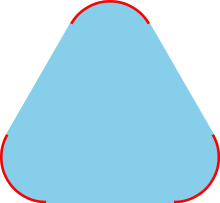Krein–Milman theorem

In the mathematical theory of functional analysis, the Krein–Milman theorem is a proposition about convex sets in topological vector spaces. A particular case of this theorem, which can be easily visualized, states that given a convex polygon, one only needs the corners of the polygon to recover the polygon shape. The statement of the theorem is false if the polygon is not convex, as then there can be many ways of drawing a polygon having given points as corners.
Formally, let be a locally convex topological vector space (assumed to be Hausdorff), and let be a compact convex subset of . Then, the theorem states that is the closed convex hull of its extreme points.
The closed convex hull above is defined as the intersection of all closed convex subsets of that contain . This turns out to be the same as the closure of the convex hull in the topological vector space. It is straightforward to show that the convex hull of the extreme points forms a subset of , so the main burden of the proof is to show that there are enough extreme points so that their convex hull covers all of .
Relation to the axiom of choice
The axiom of choice, or some weaker version of it, is needed to prove this theorem in Zermelo–Fraenkel set theory. Conversely, this theorem together with the Boolean prime ideal theorem can prove the axiom of choice.[1]
Related results
Under the previous assumptions on if is a subset of and the closed convex hull of is all of , then every extreme point of belongs to the closure of This result is known as Milman's (partial) converse to the Krein–Milman theorem.[2]
The Choquet–Bishop–de Leeuw theorem states that every point in is the barycenter of a probability measure supported on the set of extreme points of
More general settings
The assumption of local convexity for the ambient space is necessary, because James Roberts (1977) constructed a counter-example for more general spaces.[3]
Linearity is also needed, because the statement fails for weakly compact convex sets in CAT(0) spaces, as proved by Nicolas Monod (2016).[4] However, Theo Buehler (2006) proved that the Krein–Milman theorem does hold for metrically compact CAT(0) spaces.[5]
History
The original statement proved by Mark Krein and David Milman (1940) was somewhat less general than the form stated here.[6]
Earlier, Hermann Minkowski (1911) proved that if is 3-dimensional then equals the convex hull of the set of its extreme points.[7] This assertion was expanded to the case of any finite dimension by Ernst Steinitz (1916).[8] The Krein–Milman theorem generalizes this to arbitrary locally convex ; however, to generalize from finite to infinite dimensional spaces, it is necessary to use the closure.
See also
- Carathéodory's theorem (convex hull)
- Shapley–Folkman lemma
- Helly's theorem
- Radon's theorem
- Choquet theory
- Banach–Alaoglu theorem
References
- ^ Bell, J.; Fremlin, David (1972). "A geometric form of the axiom of choice" (PDF). Fundamenta Mathematicae. 77 (2): 167–170. Retrieved 11 June 2018.
Theorem 1.2. BPI [the Boolean Prime Ideal Theorem] & KM [Krein-Milman] ⇒ (*) [the unit ball of the dual of a normed vector space has an extreme point]…. Theorem 2.1. (*) ⇒ AC [the Axiom of Choice].
- ^ Milman, D. (1947), Характеристика экстремальных точек регулярно-выпуклого множества [Characteristics of extremal points of regularly convex sets], Doklady Akademii Nauk SSSR (in Russian), 57: 119–122
- ^ Roberts, J. (1977), "A compact convex set with no extreme points", Studia Mathematica, 60: 255–266
- ^ Monod, Nicolas (2016), "Extreme points in non-positive curvature", Studia Mathematica, 234: 265–270, arXiv:1602.06752
- ^ Buehler, Theo (2006), The Krein–Mil'man theorem for metric spaces with a convex bicombing, arXiv:math/0604187
- ^ Krein, Mark; Milman, David (1940), "On extreme points of regular convex sets", Studia Mathematica, 9: 133–138
{{citation}}: Cite has empty unknown parameter:|1=(help) - ^ Minkowski, Hermann (1911), Gesammelte Abhandlungen, vol. 2, Leipzig: Teubner, pp. 157–161
- ^ Steinitz, Ernst (1916), "Bedingt konvergente Reihen und konvexe Systeme VI, VII", J. Reine Angew. Math., 146: 1–52; (see p. 16)
Further reading
- N. K. Nikol'skij (Ed.). Functional Analysis I. Springer-Verlag, 1992.
- H. L. Royden, Real Analysis. Prentice-Hall, Englewood Cliffs, New Jersey, 1988.
This article incorporates material from Krein–Milman theorem on PlanetMath, which is licensed under the Creative Commons Attribution/Share-Alike License.






